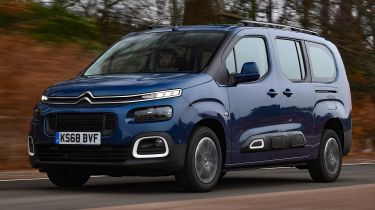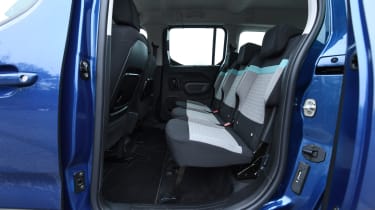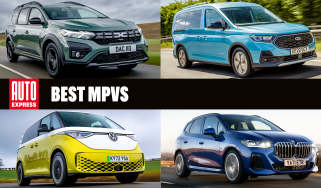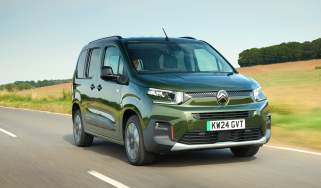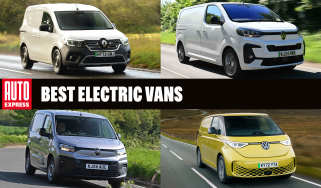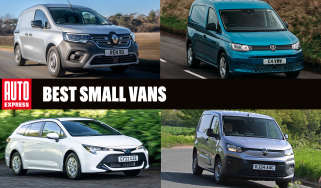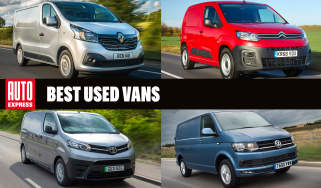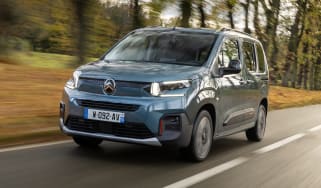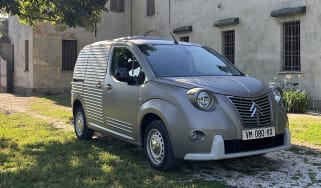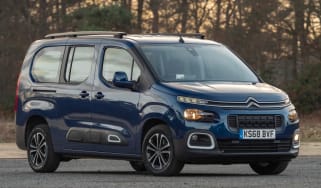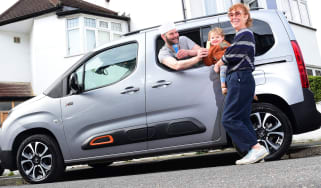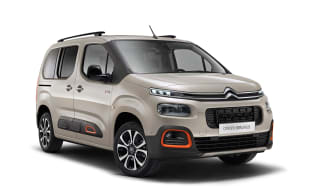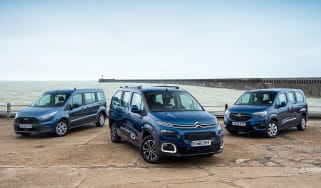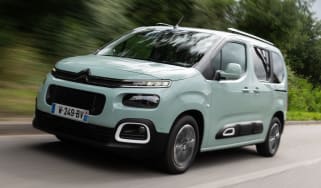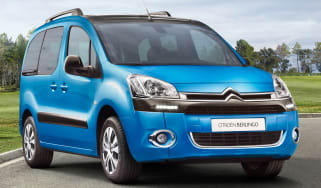Citroen Berlingo review
Bargain MPV remains one of the best value ways to transport a growing family and everything that goes with it

The Citroen Berlingo has always been a great MPV and an ideal family car thanks to the generous passenger and boot space, low running costs and great value it offers. The latest iteration improves on each of those areas even further, plus it’s much better to drive, reasonably comfortable and certain versions can seat seven. It’s also offered with a choice of petrol, diesel or pure-electric power, with the e-Berlingo one of the few EVs available with seven seats right now. Sure, the Berlingo doesn’t have kerb appeal of a typical family SUV, but those with more sense than money should have it on their next family car shortlist.
About the Citroen Berlingo
Ever since it launched in 1996, the Citroen Berlingo has taken a different approach to its MPV rivals. While most were developed from the ground up to be cars first and foremost, the Citroen used more humble van underpinnings. Adding windows and seats to a popular commercial vehicle made for a rugged, simple and affordable alternative to the mainstream. This ‘van with windows’ formula is one that Citroen and others continue to employ, with its current crop of rivals like the Volkswagen Caddy, Peugeot Rifter, Vauxhall Combo Life and Mercedes T-Class all following a similar recipe.
Used - available now

2020 Citroen
Berlingo
50,074 milesManualDiesel1.5L
Cash £14,797
2022 Citroen
Berlingo
42,946 milesManualDiesel1.5L
Cash £17,559
2016 Citroen
Berlingo
22,000 milesAutomaticDiesel1.6L
Cash £10,650
2016 Citroen
Berlingo
22,830 milesManualDiesel1.6L
Cash £8,995The third generation Berlingo is more car-like than ever. Under the metal is a mix of the old Berlingo and PSA’s (now Stellantis’s) EMP2 platform. The latter also serves as the underpinnings for dozens of cars, including the Citroen C5 Aircross, Peugeot 3008 and Vauxhall Grandland family SUVs, while the Berlingo’s modified platform is the same one used by the Peugeot Rifter and Vauxhall Combo Life MPVs. The result is vastly improved refinement, infotainment and safety tech compared to its predecessor.
But it’s practicality where the Citroen Berlingo has always shone, and the good news is that it’s now more useful than ever. The boxy exterior shape translates into fantastic passenger and boot space, while deep cubbies, a huge glovebox and a host of other clever storage spaces shows that genuine thought has been invested in the cabin.
There are two body styles to choose from: the M model is the standard model, while the XL measures 35cm longer – enough space for a third row of seats, taking the total from five to seven. There are two trim levels to choose from: Feel and range-topping Flair XTR. Standard kit includes an eight-inch touchscreen, Apple CarPlay, Android Auto, rear parking sensors, myriad safety systems and Citroen’s ‘airbump’ panels on the doors which protect against minor dings in supermarket car parks.
In addition to the size and specification, buyers also have a choice of power sources. Base models feature a 1.2-litre PureTech 110 petrol engine under the bonnet, while those who cover lots of miles will find the 1.5-litre BlueHDi 100 and 130 diesel motors more appealing. The more powerful BlueHDi 130 is the only engine available with Citroen’s eight-speed automatic, with the other two paired with a simple six-speed manual gearbox.
If you’re after a greener option, there’s the pure-electric e-Berlingo. It uses a 50kWh battery to power a single electric motor that drives the front wheels. Citroen says the e-Berlingo will cover up to 177 miles on a single charge, and can charge from 0 to 80 per cent in just half an hour.
Engines, performance and drive
The Berlingo’s underpinnings are a mish-mash of technologies. The rear half is largely unchanged from the previous model, allowing for a similarly huge load area, while the front is based on the EMP2 platform used by cars ranging from hatchbacks to family SUVs. Doing so allowed Citroen to install the latest suite of safety tech and chassis refinements.
The result is that, for the most part, the Berlingo drives more like a car than a van. The steering is light, the turning circle is tight and, while the high centre of gravity makes itself felt during hard cornering, body roll is controlled well enough. There's decent grip and the brakes feel strong and reassuring.
The ride is smooth enough, though the harshest bumps vibrate around the cabin. There’s quite a lot of wind noise at motorway speeds, particularly around the bulky door mirrors, but that’s not particularly surprising considering this is a large box on wheels. At least the large amounts of glass, big side mirrors and slightly elevated driving position mean you get a decent view out.
Driving the electric e-Berlingo is largely the same, but with the added benefits of near-silent running, no gearbox to deal with and a generous amount of torque available as soon as you tap the accelerator. The e-Berlingo is great when you’re pottering around town, especially when you engage the ‘B’ mode that increases the regenerative braking, though it’s not capable of one-pedal driving like some other family-friendly EVs.
0-62mph acceleration and top speed
Under the bonnet, there’s a choice of a 1.2-litre petrol with 108bhp, a 1.5-litre diesel in one of two power outputs – 99bhp and 128bhp – and a single electric motor with 134bhp on tap.
The most powerful diesel offers up a useful 300Nm of torque – handy when carrying a full complement of passengers and their luggage. The top-end diesel accelerates from 0-62mph in 11 seconds and on to a top speed of 114mph. The entry-level oil-burner is a little bit slower on paper, as Citroen says this version takes 14.1 seconds to reach 62mph, and it has a slightly lower 106mph top speed, though that shouldn’t concern UK drivers.
The 108bhp petrol model’s 11.5-second 0-62mph time translates into decent real world performance, while the linear power delivery makes the Berlingo easy to control at low speeds. The petrol Berlingo also has a top speed of 107mph.
Whichever fuel you go for, the Berlingo remains fairly smooth and refined, with the two diesels the better pick for regular longer trips or towing duties.
Available gearboxes include a six-speed manual and an eight-speed automatic, though the one you’ll be able to have depends on which engine you go for. The manual is the only gearbox offered on the 108bhp petrol and 99bhp diesel; in contrast, the 128bhp only comes with the auto.
The e-Berlingo’s electric motor sends all its 134bhp and 260Nm of torque to the front wheels, and will sprint to 62mph in a leisurely 11.5 seconds, with a modest top speed of 84mph. The EV’s three driving modes – Eco, Normal and Power – affect the amount of power on tap, with the most powerful reserved for when the car is chockablock with people and their stuff.
Day to day around town, we’d recommend driving the Citroen in Normal mode, and switching to Eco for when you have to get the most range out of the battery as this setting not only limits power, but the climate control as well, which isn’t great in the blistering heat or freezing winters.
MPG, CO2 and running costs
The Berlingo is offered with a choice of petrol or diesel engines, or you can get the pure-electric e-Berlingo, which is by far the most expensive option in the range, but it should be the cheapest to run in the long term.
That said, a good many people aren’t quite ready to make the switch to electric, or don’t have anywhere they could charge an EV. In that case, whether you pick a petrol or a diesel, the Berlingo’s engines sip fuel rather than guzzle it down, plus they all benefit from stop/start technology, which helps to save fuel in heavy traffic.
The pick of the engines is the mid-range BlueHDi 100 diesel, as Citroen claims this 1.5-litre oil-burner can return up to 54.4mpg. The BlueHDi 130 uses a more powerful version of the same 1.5-litre four-cylinder diesel motor, so unsurprisingly it’s less efficient, capable of returning 51.9mpg at best.
Still, it’s more frugal than the petrol offering. The PureTech 110 is a 1.2-litre turbocharged three-cylinder motor that, in the Berlingo, will achieve between 37-48mpg. At those rates, you should be able to cover up to 500 miles if you fill the Berlingo’s 61-litre fuel tank.
CO2 figures (measured using WLTP regulations) range from 149g/km in the lowest-powered diesel model, rising to 158g/km in the petrol model; these figures do not change if you opt for the long-wheelbase versions.
Electric range, battery and charging
Both the e-Berlingo M and XL use a 50kWh battery which allows for a maximum driving range of 177 and 168 miles, respectively. Those figures are not ideal if you frequently visit family over 300 miles away – as we learned when we ran an e-Berlingo Flair XTR M as a long-term test car. However we did find that driving around town in eco mode, and with the stronger regenerative braking setting activated, we could get close to the e-Berlingo’s claimed range.
The e-Berlingo has a maximum charging speed of 100kW, so if you decide to take the electric MPV on a longer journey, topping up from 0 to 80 per cent will take just 30 minutes if you use a suitably fast rapid charger. Day to day though, most people charge their cars at home or using slower public charging points nearby. A standard 7kW home wallbox needs seven and a half hours to fully replenish the e-Berlingo’s 50kWh battery.
Insurance groups
As the Berlingo offers little in the way of sporty intent, insurance costs should prove to be modest throughout the range. Insurance group ratings start from 12 for the least powerful petrol version in entry-level Feel trim, and climb to group 20 for the top-of-the-range e-Berlingo XL in Flair XTR trim.
Check your tax status and renewal date in seconds. Check your VED car tax now...
Depreciation
Due to their popularity, family SUVs and crossovers will retain more of their original value compared to MPVs like the Berlingo, though the depreciation shouldn’t be disastrous. Our latest expert data suggests the e-Berlingo should hold onto around 48 per cent of its list price after three years and 36,000 miles of ownership, and we expect the petrol and diesels to be just behind come trade-in time.
To get an accurate valuation on a specific model check out our free car valuation tool...
Interior, design and technology
In typical Citroen fashion, the Berlingo takes a slightly quirky approach to its styling. The external ‘airbump’ panels not only break up the vast metal panels along the side, but bring the added bonus of protecting the paintwork from car park dings. Feel models are equipped with wheel trims, while Flair XTR models come with larger 17-inch alloy alloys. The double-decker headlights keep faithful to the current Citroen family look and colourful highlights add character to the boxy body that the Peugeot Rifter and Vauxhall Combo Life arguably lack.
Like the outside, much of the trio’s cabins are shared with one another. That means there’s a large, raised dashboard which houses the gear lever (or gear selector in automatic and electric models), and a simple layout which prioritises ergonomics and storage space over style. The Berlingo gets traditional dials, unlike the Rifter, which uses Peugeot’s i-Cockpit setup that places the dials above a small-diameter steering wheel.
Design and build quality has taken a significant leap forward over the previous-generation Berlingo, though those used to the squidgy plastics and damped switches of more conventional cars might still find it a little agricultural. However, while the plastics are hard, they do feel sturdy and more than capable of withstanding anything life as a family car might throw at it.
Sat-nav, stereo and infotainment
All models are equipped with an eight-inch touchscreen infotainment system. The system itself looks smart enough, but some on-screen buttons are quite small and fiddly, and it's quite laggy. Built-in navigation only comes as standard on Flair XTR models, though it is optional on base models. In reality, most people will just use the navigation apps from their phones via Apple CarPlay or Android Auto, both of which are standard across the range.
Sound quality from the six-speaker hi-fi is reasonable, but it won’t impress any music-mad MPV/SUV buyers. Many other Citroen models integrate heating and climate controls into a touchscreen, but the Berlingo keeps physical buttons and switches which, in our opinion, are much easier and less distracting to use on the move.
Practicality, comfort and boot space
Most MPVs are designed with practicality at the forefront, but few others (Rifter and Combo Life relatives aside) execute this thinking as well as the Berlingo. In every interior dimension, the Berlingo is huge: head, leg and shoulder room are vast, and there’s enough width to the second row that three child seats can be fitted across its width. The large sliding rear doors make it easy to get in, too.
Then there’s the storage space. A total of 28 cubbies offer up a whopping 186 litres of volume, which is more storage than you get in the boot of a Fiat 500. They’re topped off (literally) by a clever roof storage system that Citroen calls the Modutop. It’s got an airline-style locker at the back, with a long, translucent shelf running ahead of it through the centre of the cabin. Paired with a panoramic glass roof, it’s available as part of the optional Holiday Pack on five-seater Flair XTR trim models.
The front overhang and bumper are shorter than on the old Berlingo, which improves forward visibility. Combined with the high driving position it means that drivers get a great view of the road ahead. Kids will enjoy the back seats, too; the huge areas of glass mean that it’s easy to see out.
Dimensions and size
Both the five-seat Berlingo M and seven-seater Berlingo XL measure 1,849mm tall and 2,107mm wide (including door mirrors). The Berlingo M is 4,403mm long, which makes it slightly shorter than a C5 Aircross. The XL is 350mm longer, or roughly the same length as a compact executive saloon like an Audi A4.
Leg room, head room & passenger space
It doesn’t matter which of the five seats you find yourself in, there will be little to complain about when it comes to space. The high roofline makes headroom acceptable for the tallest top-hat fanciers, and legroom is just as generous.
Young families will like the fact that each second row seat gets ISOFIX mounting points – hidden behind zipped covers – as standard. The cabin is wide enough to accommodate three child seats together, too. Access is easy, thanks to huge sliding doors and a flat interior floor.
XL models add a third row of seats. These aren’t quite as spacious, but passengers of average height or below will be happy enough. Access is possible from the second row, which can slide and fold forwards.
Boot space
That impressive cabin space is backed up by a vast load area. The M model’s 775-litre boot equates to 100 litres more than the old Berlingo Multispace in standard guise, and the XL gets a faintly ridiculous 1,050 litres. Folding the seats takes a simple flick of levers in the boot or on the seats themselves, and all three individual chairs drop into the floor for a near-level load area, via levers in the boot if necessary. If fitted, the sixth and seventh seats are removable altogether.
The front passenger seat folds flat and almost completely level with those behind which, according to Citroen, means the Berlingo M can take objects up to 2.7 metres long, and the XL 3.05-metres – enough for a whitewater kayak. The boot door is huge, which is great for loading but a pain in tight spaces, where the glass hatch that can open separately comes into its own. It's an option on entry-level Feel trim models, but comes as standard on Flair XTR-spec models.
Reliability and safety
Vans used to be simple machines, but the amount of safety and driver assistance tech you find on commercial vehicles these days is deeply impressive. That’s how the van-derived Berlingo features cruise control, lane keep assistance, speed limit recognition, active emergency braking and driver attention monitoring as standard, while top-spec Flair XTR models also come with a reversing camera.
The third-generation Berlingo received a four-star crash safety rating from industry experts Euro NCAP in 2018 based on how its sister car, the Peugeot Rifter, performed during its battery of tests. The Berlingo’s adult and child occupant scores of 91 and 81 per cent respectively are both very impressive, but the French MPV missed out the full five-star rating due to a less favourable 58 per cent score in the vulnerable road users category. This was caused by solid areas around the base of the windscreen pillars, which could cause injury to pedestrians or cyclists in the event of a collision.
NCAP also found the emergency braking system to be less effective at higher speeds, but considered the lane keeping system – which can actively steer the car back on course if it drifts out of lane – to be very useful.
Unfortunately the Citroen Berlingo didn’t make an appearance on our latest best cars to own list, which is based on owners' feedback from our Driver Power customer satisfaction survey. However four other Citroen models did crack the 75-car strong list; in fact, the Mk3 Citroen C4 took first place. Meanwhile, Citroen as a brand finished 11th in the best car manufacturer rankings – ahead of rivals Vauxhall, Volkswagen, Fiat and Renault, to name but a few.
Warranty
All new Citroen vehicles come with a three-year/60,000-mile warranty, but the e-Berlingo’s battery pack is covered by a separate eight-year/100,000-mile guarantee. Also included is a 12-year anti-perforation warranty and three years’ cover for paint.
Servicing
Equipped with Citroen’s more modest petrol and diesel engines, servicing costs for the Berlingo should be affordable, and potential even less for the electric e-Berlingo as EVs tend to be more reliable than their combustion-engine counterparts. Citroen offers a service plan that allows you to spread the cost of maintenance, or pay for it in a single fee.
Used and nearly new Citroen Berlingo
The Berlingo's ‘van with windows’ formula has proven incredibly popular, with Citroen shifting more than three million units of the Berlingo in the past two decades. It remains one of Citroen’s biggest sellers worldwide, so you should have little trouble finding a used Citroen Berlingo for your budget if a new car doesn't quite fit the bill.
Citroen Berlingo Mk3: 2018-
The current Citroen Berlingo is the best of the breed, as you'd expect. More car-like than ever, with a subtle hint of SUV in the styling, it uses a platform shared with the likes of the Citroen C5 Aircross and Peugeot 3008. This means it’s safer and more refined than before, with the latest tech you’d expect to find in a modern family car. It might look like a van, but it doesn’t feel like one when you’re inside. Practicality is now desirable. Read our full Mk3 Citroen Berlingo buyer’s guide here...
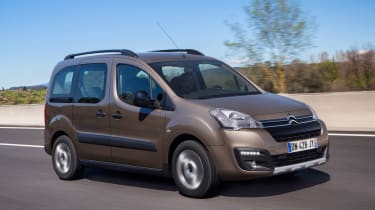
Citroen Berlingo Multispace Mk2: 2008-2018
It’s not the most stylish car on the market, but few cars offer such a compelling blend of practicality and value for money. The diesel versions should be inexpensive to run, and reliability is good, providing you buy a good example. The Mk2 Berlingo Multispace was one of a relatively rare-breed of van-based people-carriers, which accounts for its exceptional space efficiency. It shares its underpinnings with the Peugeot Partner, has highly practical sliding side doors and can transport seven passengers. If you take the last row of seats out, the luggage area is a whopping 3,000 litres. Read our full Mk2 Citroen Berlingo buyer’s guide here…
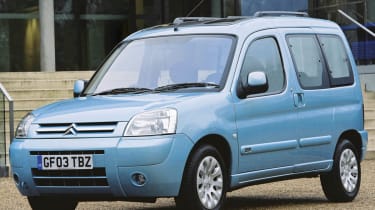
Citroen Berlingo Multispace Mk1: 1996-2008
This is where it all began for the Citroen Berlingo. Claims that MPVs were nothing more than vans with windows didn’t worry Citroen when it launched its original Berlingo in 1998, playing on the fact this boxy people-carrier was derived from a van in order to offer as much practicality as possible. Being based on a van meant immense practicality for relatively little outlay, while with no sporting pretensions, owners also loved the comfort offered by their Berlingos.

